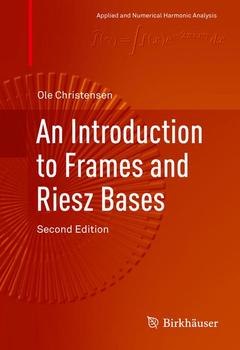Description
An Introduction to Frames and Riesz Bases (2nd Ed., Softcover reprint of the original 2nd ed. 2016)
Applied and Numerical Harmonic Analysis Series
Author: Christensen Ole
Language: English
Subject for An Introduction to Frames and Riesz Bases:
Publication date: 06-2016
Support: Print on demand
Publication date: 05-2018
Support: Print on demand
Description
/li>Contents
/li>Biography
/li>Comment
/li>
This revised and expanded monograph presents the general theory for frames and Riesz bases in Hilbert spaces as well as its concrete realizations within Gabor analysis, wavelet analysis, and generalized shift-invariant systems. Compared with the first edition, more emphasis is put on explicit constructions with attractive properties. Based on the exiting development of frame theory over the last decade, this second edition now includes new sections on the rapidly growing fields of LCA groups, generalized shift-invariant systems, duality theory for as well Gabor frames as wavelet frames, and open problems in the field.
Key features include:
*Elementary introduction to frame theory in finite-dimensional spaces
* Basic results presented in an accessible way for both pure and applied mathematicians
* Extensive exercises make the work suitable as a textbook for use in graduate courses
* Full proofs includ
* Explicit constructions of frames and dual pairs of frames, with applications and connections to time-frequency analysis, wavelets, and generalized shift-invariant systems
* Discussion of frames on LCA groups and the concrete realizations in terms of Gabor systems on the elementary groups; connections to sampling theory
* Selected research topics presented with recommendations for more advanced topics and further readin
g* Open problems to stimulate further research
An Introduction to Frames and Riesz Bases will be of interest to graduate students and researchers working in pure and applied mathematics, mathematical physics, and engineering. Professionals working in digital signal processing who wish to understand the theory behind many modern signal processing tools may also find this book a useful self-study reference.
Review of the first edition:
"Ole Christensen?s An Introduction to Frames and Riesz Bases is a first-rate introduction to the field ? . The book provides an excellent exposition of these topics. The material is broad enough to pique the interest of many readers, the included exercises supply some interesting challenges, and the coverage provides enough background for those new to the subject to begin conducting original research."
? Eric S. Weber, American Mathematical Monthly, Vol. 112, February, 2005
These books may interest you

Finite FramesTheory and Applications 168.79 €

Multivariate Wavelet Frames 105.49 €

Multivariate Wavelet Frames 105.49 €

